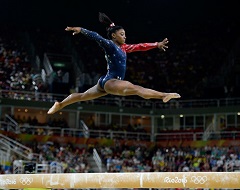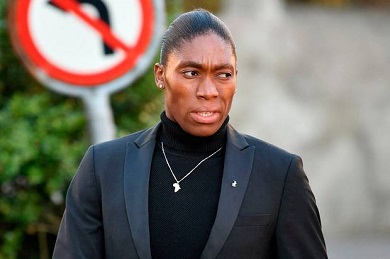In the cause of equality
Please pardon me for tapping this out – and if I confess at the outset to being an old-fashioned out of touch dinosaur I’m sure Rusters won’t be surprised – but, as someone who believes that human beings are basically born male or female, I’m quietly content with the outcome of the Court of Arbitration in Sport’s appeal lodged by Caster Semenya, the 28 year-old South African athlete whose most famous track exploits so far have been the winning of the women’s 800 metres gold medal at both the 2012 and 2016 Olympics.
 That doesn’t mean to say that I deny that the issues surrounding gender and sporting excellence are not complicated, tortuous and for that matter in many ways unfortunate and sad.
That doesn’t mean to say that I deny that the issues surrounding gender and sporting excellence are not complicated, tortuous and for that matter in many ways unfortunate and sad.
See here for a piece by Andy Bull that appears upon the website of – THE GUARDIAN
However, I cannot quite reach for the old adage “There are no winners in this” – because I take the view there are, viz. ‘ordinary’ female athletes.
 (And here there’s immediately a minefield of variances along a spectrum perhaps even in that simple statement because of the infinite variety of what constitutes ‘ordinary’. For present purposes I’m referring to those of the female gender whose bodies have not been saddled … or should that be ‘blessed … with the natural advantage of an in-built and genetic [and here, of course, I’m delving into realms of human physiology and/or medicine I know little to nothing about] ability to produce testosterone in quantities that give them a distinct advantage in sporting activities in which raw power, stamina and strength are at a premium).
(And here there’s immediately a minefield of variances along a spectrum perhaps even in that simple statement because of the infinite variety of what constitutes ‘ordinary’. For present purposes I’m referring to those of the female gender whose bodies have not been saddled … or should that be ‘blessed … with the natural advantage of an in-built and genetic [and here, of course, I’m delving into realms of human physiology and/or medicine I know little to nothing about] ability to produce testosterone in quantities that give them a distinct advantage in sporting activities in which raw power, stamina and strength are at a premium).
Cutting straight to what seems to me to be the nub of the controversy – this is all to do with the principle of a ‘level playing field’ when it comes to competitive sport, especially at the elite level.
 From my viewpoint, athletes with ‘Differences in sex development’ (DSD) – including what I think is called hyperandrogenism in Semenya’s case – do have a distinct advantage in ‘female’ versions of events/competitions in which power, stamina and strength are likely to be key influencers.
From my viewpoint, athletes with ‘Differences in sex development’ (DSD) – including what I think is called hyperandrogenism in Semenya’s case – do have a distinct advantage in ‘female’ versions of events/competitions in which power, stamina and strength are likely to be key influencers.
Simply because ‘ordinary’ women necessarily have a limited potential supply of these, no matter how otherwise physically blessed they may be or indeed how hard they work and train at their event(s).
 You’ll note that when it comes to female sports/activities in which femininity, grace and artistic impression are key markers in the scoring system (usually those in which subjective judging plays a part, e.g. gymnastics in its various forms, including throwing a ball up in the air, or indeed whirling around a baton with a piece of fabric fluttering behind it, whilst then doing various acrobatics before catching said item again as it comes down again, and also examples like figure skating) – at least, so far as I am aware – the participation of DSD athletes is less of a thorny issue, even if it exists at all.
You’ll note that when it comes to female sports/activities in which femininity, grace and artistic impression are key markers in the scoring system (usually those in which subjective judging plays a part, e.g. gymnastics in its various forms, including throwing a ball up in the air, or indeed whirling around a baton with a piece of fabric fluttering behind it, whilst then doing various acrobatics before catching said item again as it comes down again, and also examples like figure skating) – at least, so far as I am aware – the participation of DSD athletes is less of a thorny issue, even if it exists at all.
Because the problem currently at hand is all about events in which the male (testosterone) characteristics – power, strength etc. – give a natural advantage.
 The difficulty, inevitably, is in finding a balance.
The difficulty, inevitably, is in finding a balance.
Because, of course, (for example) athletes with natural physiques suited to particular events are always likely to do better in them, plus also (by the process of ‘finding a sport that suits them’ and any logical scouting system) they will gravitate, or be encouraged, towards them.
Let me just list some ‘for instances’: kids who are naturally going to be tall and possessed of ‘long levers’ [rowing, football goalkeeping, netball, high jump, swimming?]; those who are going to be tall, heavy and big-boned [shot putt, discuss, hammer, heavyweight wrestling, boxing or weightlifting?]; those who are going to be tiny and light [gymnastics, horse racing jockeys?]; and those relatively compact and powerfully-built [sprinters].
And that’s only body types.
 In theory, and this is an argument that Caster Semenya’s lawyers and supporters should (and perhaps already have) run – if suddenly you are going to decree that ‘female’ athletes with DSD issues have to either take ‘supressing’ drugs in order to get to that desired mythical ‘level playing field’ for all female gender athletes, then it won’t be long before Afro-Caribbean athletes may have to come under scrutiny for their supposed ‘greater in-built genetic’ natural advantages in terms of speed, power and fast-twitch muscles.
In theory, and this is an argument that Caster Semenya’s lawyers and supporters should (and perhaps already have) run – if suddenly you are going to decree that ‘female’ athletes with DSD issues have to either take ‘supressing’ drugs in order to get to that desired mythical ‘level playing field’ for all female gender athletes, then it won’t be long before Afro-Caribbean athletes may have to come under scrutiny for their supposed ‘greater in-built genetic’ natural advantages in terms of speed, power and fast-twitch muscles.
Or indeed, likewise Kenyan and Ethiopian distance runners – or at least some of them – because they and their ancestors were born at – or have lived all their lives at – higher altitudes than the ‘ordinary’ Brit female who may have had the distinct disadvantage of being born in Hull as the product of a long line of fishermen families living next to a factory spewing out carbon monoxide or similar into the atmosphere [here, of course, I’m going to the absurd to make my point].
 Clearly there is also a difference between those athletes whose physiological advantages are entirely natural – and for present purposes I accept these include Caster Semenya – and those who, as used to happen in the bad old days of track & field in some Eastern European countries with state-sponsored programmes and randomly, then and now, in the Western capitalist world in which success means money and profit, deliberately took (and/or still take) performance-enhancing drugs in pursuit of success.
Clearly there is also a difference between those athletes whose physiological advantages are entirely natural – and for present purposes I accept these include Caster Semenya – and those who, as used to happen in the bad old days of track & field in some Eastern European countries with state-sponsored programmes and randomly, then and now, in the Western capitalist world in which success means money and profit, deliberately took (and/or still take) performance-enhancing drugs in pursuit of success.
To finish, I also wanted to make the point that there’s a difference between someone in Caster Semenya’s position and the modern PC-world (and to my mind nonsensical) notion of ‘transgender self-identification’.
If that ever gets hold – and the way things are going, there’s no saying that it won’t – then the day won’t be far off when the future Roger Federers and Rafael Nadals of the world might seriously consider taking advantage of the option to self-identify as a female for a couple of seasons (e.g. in pursuit of the accolade of being the first person ever to be crowned both the male and female Singles titleholder at Wimbledon) and then later switch back to identifying as male in order to resume their main career.
 On the BBC1’s local news last night I saw an interview with Jamie Windust, a person born as male who now regards himself as ‘non-binary’, which term I understand to mean that he currently regards himself as neither male nor female, but somewhere in between.
On the BBC1’s local news last night I saw an interview with Jamie Windust, a person born as male who now regards himself as ‘non-binary’, which term I understand to mean that he currently regards himself as neither male nor female, but somewhere in between.
Jamie was shaven bald, wearing white facial foundation make up (with individual stars dotted around his visage), red lipstick and sporting large ‘three gold ring’ ear-rings hanging on each ear. He also had large yellow (with sparkles on) false fingernails and spoke in a heavily ‘camp’ tone.
Apparently he is currently mounting a campaign to persuade the Government to extend its range of options in standard British passports under the heading “Gender” from boxes just allowing a tick for either ‘male’ or ‘female’ via adding another box marked ‘non-binary’.
I have to be honest – before I watched this interview I was going to conclude this blog by asking the rhetorical question “What on earth is the world coming to?!”
However, now having witnessed it, this morning I am moved to comment instead that such a question is probably superfluous – to be blunt, wherever the world was going, it already seems to have got there!
Which leads me again to the conclusion that in sport all gender classifications should be dropped altogether.
Instead, let’s just have games and events in which the best ‘person’ or team wins … and be done with all the PC-insistent positive action, and administrative crap.
After all, true ‘equality’ will only have arrived when gender is irrelevant and all that matters is excellence in performance.
It’s what the ‘equality’ campaigners seem to want – or so they say … so why not give it to them?

